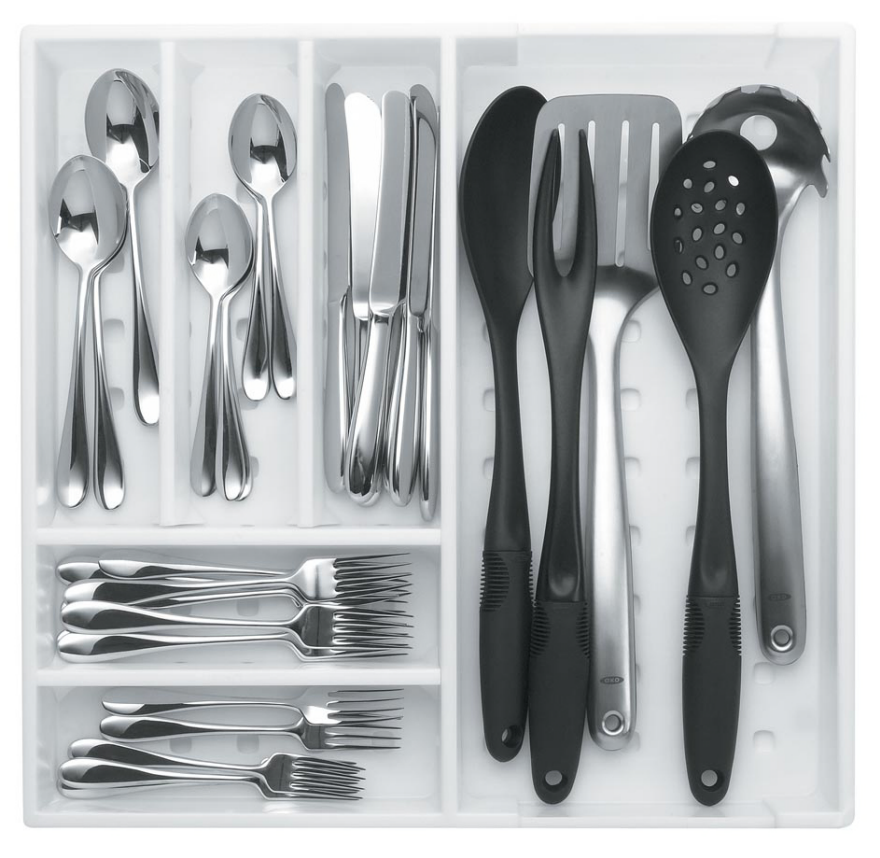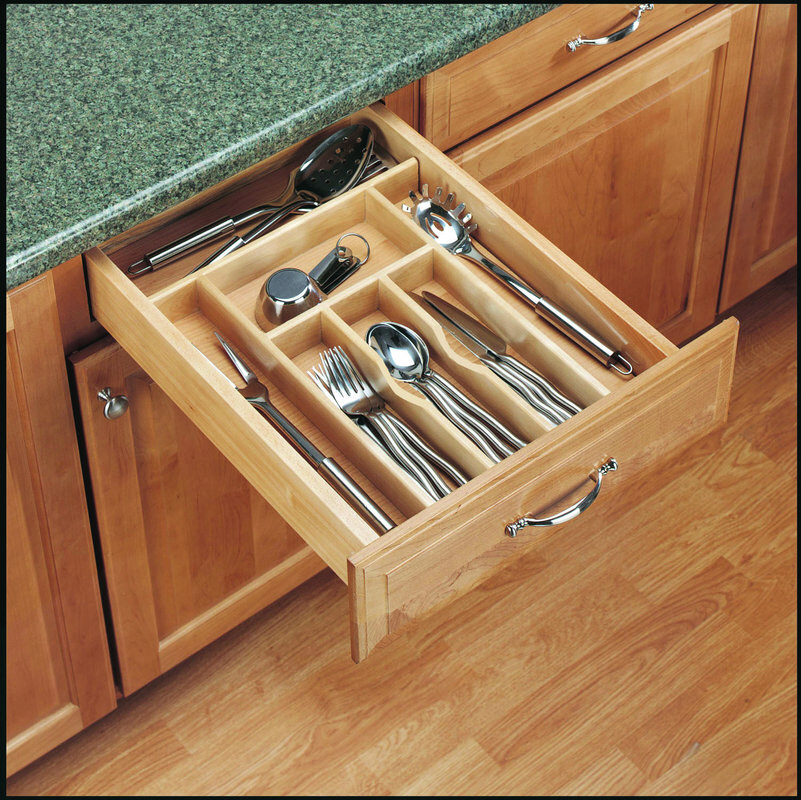
14 Ways to Organize the Kitchen Silverware Drawer
Keeping the cutlery under control
Without some sort of organizational product, kitchen silverware drawers would be a mess. But cutlery collections can be small or large, and drawer sizes vary tremendously. So what's a designer to do?
 Enter a caption (optional)
Enter a caption (optional)Expandable trays such as those from Core Bamboo and Bellemain are one solution. When unexpanded, the organizers have enough compartments for most basic silverware collections—but the two extra compartments, one on each side, will help for larger collections and bigger drawers.
 Enter a caption (optional)
Enter a caption (optional)The two halves of the expandable DrawerStore from Joseph Joseph lock into place at the size the user chooses. And a plastic organizer will be somewhat easier to clean than one made of bamboo.
 Enter a caption (optional)
Enter a caption (optional)Like the DrawerStore, the OXO Good Grips adjustable organizer has a single expandable compartment on one side. But it also has adjustable dividers on the other side, so sections can be made larger or smaller. Purchasers appreciate the versatility; one created sections for baby flatware and reusable straws. Some users would like more dividers than what it comes with (two large, two medium, and two small); providing an option to buy extra dividers would be a nice idea.
One more nice feature: This organizer also has non-slip feet to prevent it from moving around in the drawer. It's a thick plastic, and I've seen no complaints about its stability when being moved around.
 Enter a caption (optional)
Enter a caption (optional)The OXO Good Grips expandable organizer also has that single adjustable compartment to the side. But, more notably, the adjustable dividers within each compartment allow the silverware to be stacked in alternating directions. That's an innovative way to save some space. However, it does require a bit more fussing when putting the silverware away than simple open compartments do, and for some people that will make this design unworkable.
 Enter a caption (optional)
Enter a caption (optional)Some trays aren't adjustable, and they can work fine for those who have drawers that are the right size. One advantage of a tray such as this one from T&G is that it would also work just fine outside of a drawer, if need be. For example, it would be easy to haul the cutlery collection to a party if a friend needed additional tableware.
 Enter a caption (optional)
Enter a caption (optional)The Rubbermaid cutlery trays from the 1970s aren't as flexible as most other products; certain sections can only be used for spoons. But for some people, having the visual cue as to what goes where is useful.
 Enter a caption (optional)
Enter a caption (optional)For those with deep drawers, a two-tier tray such as this one from Century Components might work well. However, some people will find that they totally forget about the things in the bottom tier, which they can't see as easily.
 Enter a caption (optional)
Enter a caption (optional)Individual containers sized appropriately for silverware, such as these bamboo ones, are an alternative to a single tray. They provide a lot of flexibility, and can work fine if the set has the right components. However, they can also waste space, since they have more wall space than a single tray would have. They are also unlikely to fit a drawer's width exactly, as an expandable tray can do. But they might also fit into a space where no other product works.
 Enter a caption (optional)
Enter a caption (optional)Cut-to-size inserts are an alternative to trays. They use a bit less space in the drawer, since there are no exterior edges. The ones from Rev-A-Shelf can be trimmed with a table saw to the exact size needed.
 Enter a caption (optional)
Enter a caption (optional)Not everyone is going to have a fully equipped workspace with a table saw; drawer dividers where you just measure, score and snap will work better for some. The dividers from Lifestyle Systems aren't specifically designed for cutlery, but they could certainly be used that way.
 Enter a caption (optional)
Enter a caption (optional)Orderly Drawer makes it easy to order custom inserts sized to fit a specific drawer. There are over 30 templates to choose from regarding the layout of the fixed walls. The thin movable dividers that fit into those walls allow for quite a bit of adjustment if needs change. (Fixed dividers are another option.) The inserts come in varying heights, too, which can be very useful.
 Enter a caption (optional)
Enter a caption (optional)Another style of drawer organizer, seen mainly for storing true silverware, has the silverware stored on edge, with each piece nested in place. This requires more care and fine motor movements when putting silverware away than some other organizers, so it's certainly not for everyone.
 Enter a caption (optional)
Enter a caption (optional)For fine silverware, another interesting design is the Reed & Barton flatware drawer liner pad with its tarnish-resistant silver cloth blanket. This allows the owner to keep the silverware in a drawer rather than a chest while still providing protection for the pieces.
 Enter a caption (optional)
Enter a caption (optional)Those whose kitchens lack a silverware drawer to organize can add one beneath a kitchen cabinet, with dividers already in place.
-
o1Favorite This
-
Q3Comment
K
{Welcome
Create a Core77 Account
Already have an account? Sign In
By creating a Core77 account you confirm that you accept the Terms of Use
K
Reset Password
Please enter your email and we will send an email to reset your password.


Comments
Expandable drawers are a nice answer to a growing set of utensils. The last solution makes me wonder about where else drawers could be placed to be effectively well.
i would like to see some inovation in the depth adjustment. Closest i can ever find for my standard, run of the mill drawers is still about an inch short, which means the tray will always work its way to the back, leaving a gap, which can bug someone with minor OCD. I know you can glue, or velcro things in place, but I am not a fan of that, since it is a pain to clean if you ever move things around.
That'd definitely be neat. I have been putting a small block (cardboard, wood, etc.) behind the tray so that it can't slide to the back; no glue or Velcro required!